Naming Details - 156 Super-Sprinter
156 » Class Origins • British Rail Years • Depot Allocations • Misformed Sets • Naming Details • Accidents • Time-Line
Naming Details - 156 Super-Sprinter |
|
156 » Class Origins • British Rail Years • Depot Allocations • Misformed Sets • Naming Details • Accidents • Time-Line | |
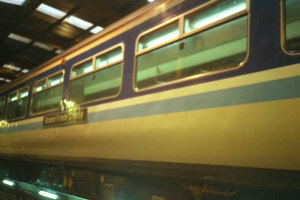
| Passenger train operators wanting to generate some good publicity may not have the option of naming a locomotive, but in many cases have decided that a multiple-unit train will do just as well. Five class 156 units received names in the mid 1990's, but four of these were removed during repainting into new liveries. After a gap of over five years with no namings, names stickers were applied to two First North Western operated units. One Railway used a proper cast nameplate in 2006, but went for large bodyside branding the following year. The latest trend is to have large bodyside picture vinyls, a policy that Northern has adopted. Details of all eight units which received names are recorded below, in order of naming. |
156.465 - Bonnie Prince Charlie (denamed)Named by Sir Donald Cameron of Locheil, at Fort William, 19 August 1995.
Charles Edward Stuart, otherwise known as ‘Bonnie Prince Charlie’ and ‘The Young Pretender,’ raised the royal standard of his exiled family at Glenfinnan, 19th August 1745, to rally the Clans loyal to the Stuart cause at the start of the doomed Jacobite uprising. ScotRail marked the 250th anniversary with the naming of the train, on which guests travelled to Glenfinnan for the re-enactment of the Raising of the Standard at the start of the 1995 Highland Games.
Nameplates were removed Autumn 2000, during repaint into ScotRail livery. The name 'Bonnie Prince Charlie' was later carried by GNER 125 power-car 43117 | |||
156.477 - Highland Festival (denamed)Named by actor Robbie Coltrane, at Inverness, 30 March 1996. | |||

| |||
|
Named to publicise ScotRail's sponsorship of the first annual Highland Festival. Saturday 30th March 1996 marked the start of a Highland Festival event called "24 Hours in the Life of the Highlands and Islands", which encouraged anyone with an interest in the arts to ‘have a go’ within the 24 hour period. Works from the project were later exhibited at six venues around the region. After the naming ceremony, the train formed the 08:10 to Kyle of Lochalsh, with craftspeople, musicians and artists on board. Nameplates were removed Autumn 2000, during repaint into ScotRail livery. | |||
156.433 - The Kilmarnock Edition (denamed)Named by Jimmy Knapp, General Secretary of the RMT union at Girvan Station, 24 September 1996.
The Kilmarnock Edition was the first published work of Robert Burns, printed in Kilmarnock in 1786. The naming marked the bicentenary of the poets death in July 1796. The unit was repainted in lined carmine and cream livery and named to launch the new 'Burns Line' services between Girvan, Ayr and Kilmarnock, supported by Strathclyde Passenger Transport (SPT). 156433 went into Glasgow Works on 5.Jan.2009 for repaint into ScotRail 'Saltire' livery and its nameplates were removed. | |||
| |||
156.454 - Whitby Endeavour (denamed)Named by Councillor Ada Myers, Mayor of Whitby at Middlesborough Station, 16 October 1997.
The original Endeavour was a three masted collier bark, built in Whitby in 1764, and with Captain James Cook at the helm set sail for the then uncharted waters of Australia four years later. The stick-on name, carried on both sides of each car, lasted until October 1999 when the unit was repainted into Northern Spirit livery. | |||
156.449 - Saint Columba (denamed)Named by John Wilson, Convenor of Argyll & Bute Council at Oban Station, 6 December 1997. Saint Columba (Colum Cille) was an Irish missionary who founded a monastery on the island of Iona in 563 in an attempt to convert the Picts to Christianity. Regarded as Scotland's second Patron Saint after Saint Andrew, the naming marked the 1,400th anniversary in 1997 of his death. Nameplates were removed June 2000, during repaint into ScotRail livery. The name 'Saint Columba' had already been given to EWS locomotive 47767, in June 1996 which it retained until February 2003. | |||
156.420 - La'al Ratty Ravenglass & Eskdale RailwayNamed by Sheila Hensman, President of Cumbria Tourist Board at Ravenglass Station, 5 July 2003. The Ravenglass & Eskdale Railway, or La'al Ratty as it is known locally, is England's oldest narrow gauge railway. The naming marked the close links between First North Western and the steam railway, which is one of the top tourist attractions in the Western Lake District. Northern Rail, which took over the FNW franchise, applied a picture livery to 156.461 in 2006, also promoting the R&ER line. |
|||
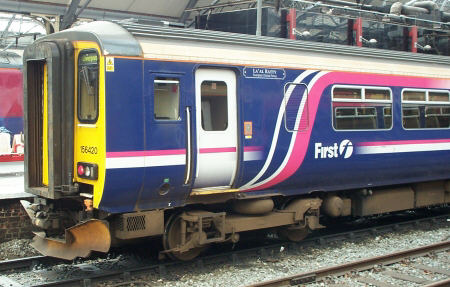
|
156.420 at Liverpool Lime Street, July 19, 2004. The unit carries First livery and the name sticker is applied behind the drivers side door, above window level.
|
Named by comedian Barry Cryer, at Buxton Station, 5 June 2004.
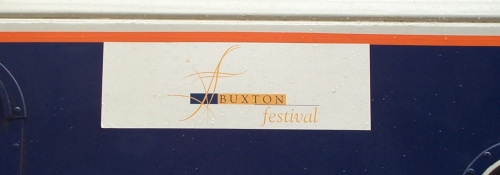
The Buxton Festival is a 17-day extravaganza of opera, classical music and literary talks based in and around the magnificent Buxton Opera House.
The naming marks the sponsorship of the festival by First North Western and highlights the public transport links to the Derbyshire town.
The unit carries First livery and the name sticker is applied behind the drivers side door, above window level.
By 2006 the logo on the sticker had faded to almost nothing, leaving only a white rectangle as evidence of the 'naming'.
Named by BBC Radio Suffolk breakfast presenter Mark Murphy and East Anglian Daily Times editor Terry Hunt at Ipswich Station, 28 November 2006.
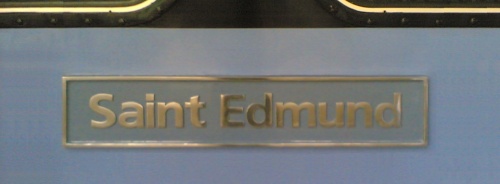
Saint Edmund was a 9th century King of East Anglia, and maryr. BBC Radio Suffolk started a campaign to have Saint Edmund replace St George as the patron saint of England.
One Railway pledged its support to campaign, by naming the class 156 unit. [news item]
The name 'Saint Edmund' was previously carried by locomotive 86430, and DMU 150213 was formerly named 'King Edmund'.
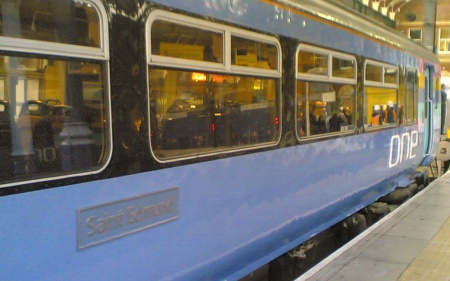
|
The nameplates are applied to both sides of car 52416 156416 is seen at Norwich station, the day before naming. Photo: Top Can |